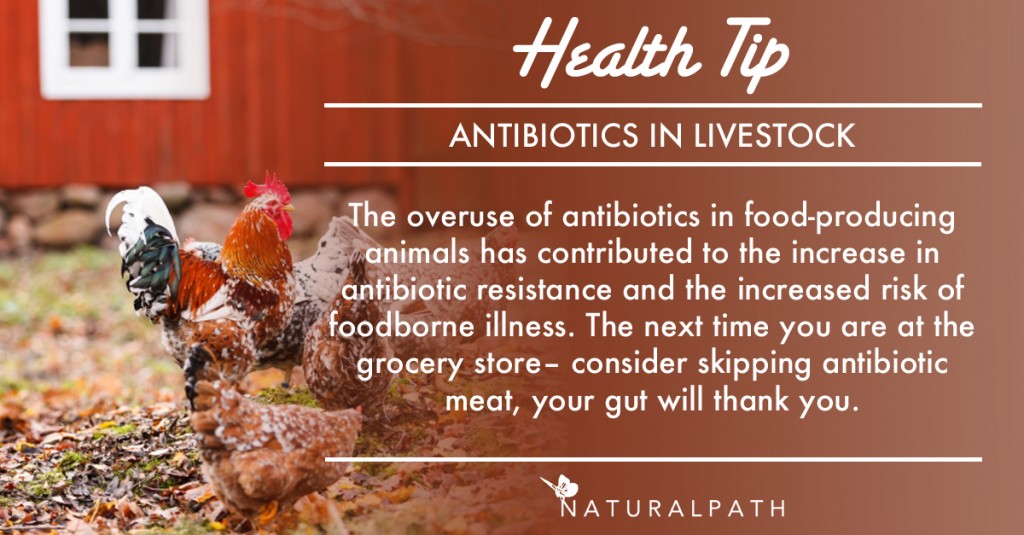A novel idea, using probiotics to prevent bacterial disease in our food sources thereby protecting against foodborne illness.
Exposure to pathogens residing in our livestock is a direct risk for the development of food poisoning. The overuse of antibiotics in food-producing animals has contributed to the increase in antibiotic resistance and the increased risk of foodborne illness.1 Probiotic and prebiotic additives to animal feed offer a promising solution.
With the plethora of research on probiotics in humans for disease prevention, the next logical step is to consider the supportive benefits imparted on our food chain.
Antibiotics versus Probiotics
Antibiotics have been being added to animal feed to promote muscle growth and prevent illness. 2 The concern is now how these incremental doses of antibiotics in our livestock in turn affect us, the consumer. The risk of antibiotic resistant genes transmitting to humans led to the banning of their use as growth enhancers in livestock in the European Union since 2006. 3
Salmonella poisoning is the leading cause of food illness due to improper handling and cooking of raw meat, particularly poultry and eggs. Over 100,000 individuals will succumb to salmonella poisoning, requiring antibiotics to treat the illness.4 This poses a difficult challenge for physicians who are left with multi-antibiotic resistant salmonella and a limited number of antibiotics they can use to treat. 5
Campylobacter is the second most common food born illness second to Salmonellosis, also from undercooked or improper handling of raw meat, especially poultry. With as little as one drop of raw chicken juice, campylobacter infection can take hold leading to diarrhea, vomiting, and fever. Various strains of campylobacter species have been found to reside in the digestive tracts of animals at low enough level as not to infect the animal, increasing the threat of contamination of milk, meat, and even water with this bacterium.6
A Promising Solution
Studies have found that a mix of both Bifidobacterium and Lactobacillus species were most effective at reducing the adherence of Salmonella and E. coli in the mucosal lining of the porcine digestive tract. This combination also seemed to reduce post-weaning diarrhea rates in piglets, improving their rate of survival. 7
The use of probiotic Lactobacillus strains improved body weight gain and reduced abdominal fat in poultry. A blend of Lactobacillus, Enteroccus, Bifidobacterium and Pediococcus strains added to the water of broiler chickens proved comparable to avilamycin (antibiotic) treatment on growth-promoting effects. 8 An interesting find is the improved feed conversion ratio of chickens supplemented with probiotics. This ratio is a measure of the efficiency in which an animal converts feed into the desired output, typically larger body mass size or increased output of eggs. Blends of Lactobacillus, Bifidobacterium and Enterococcus improved egg size and increased egg production. 9
Just as research shown benefit on probiotics in human health, it is only appropriate that we focus on our food supply and the way their probiotic makeup can and will affect us. Food for thought the next time you are at the grocery store– consider skipping antibiotic meat, your gut will thank you.
 Dr. Ashley Burkman received her Doctor of Naturopathic Medicine degree from the National University of Health Sciences in Chicago. She is deeply rooted in classical naturopathic medicine, practicing the belief that the human body has an innate ability to heal itself. She works with patients toward lifestyle adjustments in order to bring about long-term health. Viewing the body as an integrated whole and addressing all aspects of what determines health is the cornerstone of both naturopathic medicine and Dr. Burkman’s practice.
Dr. Ashley Burkman received her Doctor of Naturopathic Medicine degree from the National University of Health Sciences in Chicago. She is deeply rooted in classical naturopathic medicine, practicing the belief that the human body has an innate ability to heal itself. She works with patients toward lifestyle adjustments in order to bring about long-term health. Viewing the body as an integrated whole and addressing all aspects of what determines health is the cornerstone of both naturopathic medicine and Dr. Burkman’s practice.
Dr. Ashley Burkman is a licensed naturopathic physician in the state of Connecticut. Commitment to the growth of her profession has lead her to participate in the several campaigns to expand the scope of practice of naturopathic physicians in several states. She is also a member of both the Connecticut Naturopathic Association and American Association of Naturopathic Physicians.
Dr. Burkman, an Iowa native, enjoys perusing local farmers markets, spending time with friends and family, and searching for new hiking trails to conquer. She attends comedy shows and baseball games regularly and has a soft spot for cats.
Dr. Burkman and Dr. Lauren Young practice as fully licensed Naturopathic Physicians at Connecticut Natural Health Specialists, LLC, in Manchester, CT. Most major health insurances accepted. New patients are encouraged to call for an appointment.
References:
- Gaggìa, F, Mattarelli, P, Biavati, B. Probiotics and prebiotics in animal feeding for safe food production. International Journal of Food Microbiology. 2010;141. doi:10.1016/j.ijfoodmicro.2010.02.031.
- Dibner, JJ, Richards, JD. Antibiotic growth promoters in agriculture: history and mode of action. Poultry Science. 2005;84(4):634–643. doi:10.1093/ps/84.4.634.
- EUR-Lex Access to European Union law. EUR-Lex. 2003. Available at: http://eur-lex.europa.eu/legal-content/en/txt/?uri=celex%3a32003r1831. Accessed November 8, 2015.
- Salmonella and Chicken: What You Should Know and What You Can Do. Centers for Disease Control and Prevention. 2013. Available at: http://www.cdc.gov/features/salmonellachicken/index.html. Accessed November 8, 2015.
- Young, I, Rajić, A, Wilhelm, BJ, Waddell, L, Parker, S, Mcewen, SA. Comparison of the prevalence of bacterial enteropathogens, potentially zoonotic bacteria and bacterial resistance to antimicrobials in organic and conventional poultry, swine and beef production: a systematic review and meta-analysis. Epidemiol Infect Epidemiology and Infection. 2009;137(09):1217. doi:10.1017/s0950268809002635.
- Humphrey, T, O’brien, S, Madsen, M. Campylobacters as zoonotic pathogens: A food production perspective. International Journal of Food Microbiology. 2007;117(3):237–257. doi:10.1016/j.ijfoodmicro.2007.01.006.
- Collado, MC, Grześkowiak, Ł, Salminen, S. Probiotic Strains and Their Combination Inhibit In Vitro Adhesion of Pathogens to Pig Intestinal Mucosa. Current Microbiology Curr Microbiol. 2007;55(3):260–265. doi:10.1007/s00284-007-0144-8.
- Kalavathy, R, Abdullah, N, Jalaludin, S, Ho, Y. Effects of Lactobacillus cultures on growth performance, abdominal fat deposition, serum lipids and weight of organs of broiler chickens. British Poultry Science. 2003;44(1):139–144. doi:10.1080/0007166031000085445.
- Davis, G, Anderson, K. The effects of feeding the direct-fed microbial, primalac, on growth parameters and egg production in single comb white leghorn hens. Poultry Science. 2002;81(6):755–759. doi:10.1093/ps/81.6.755.

